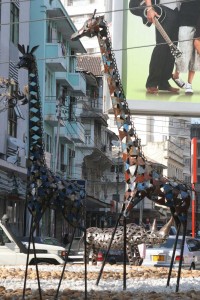by Mark Gillies
Just as in the natural world, when the months of April bring rain, growth and much activity in Tanzania, the three months since the last edition of TA have been full of incident in the fields of tourism and environmental conservation.
New Minister
On 4 May, the BBC reported that following the highly critical report by the Controller & Auditor General’s Office which described extensive misuse of funds, President Kikwete sacked the Minister of Natural Resources & Tourism. He was replaced by Ambassador Kagasheki, a man of whom much is expected, and who has reportedly taken to his new post with vigour. In his opening address to the civil servants of the Ministry, Ambassador Kagasheki was quoted as saying, “This is a sensitive ministry, which deals with foreigners, and therefore there is an urgent need to cleanse its tarnished corporate image.” This was taken by many as a clear condemnation of his predecessor. Tourism generates more income than mining, agriculture, or any other sector of the economy. (Dr Wolfgang Thome, ETN Uganda).
Crime
In June, the circumstantial stories of an increase in the reported incidents of violent crime in Tanzania gained a human face when a Dutch tourist and a local camp manager were killed during a robbery on the borders of the Serengeti National Park. Conscious of the potential impact of such events, police searched the area in force and made a number of arrests. Three men have subsequently been charged and await trial for murder.
On the rebound
However, despite these negative news stories, and the western economic malaise that has hit the long-haul travel industry hard, the new Minister has asserted that Tanzania’s tourism industry is ‘on the rebound’, using the increase in international airlines flying into Kilimanjaro International Airport (KIA) as his example of vibrancy in the tourism market. (Marc Nkwame, Daily News) Speaking at the reception for the inaugural Qatar Airways service, the Minister said the increase in traffic would benefit both the Tanzanian tourism industry and the airlines.
Kenya Airways recently started a six times a week service into KIA, while Emirates and Turkish Airways have expressed an interest in using the airport. To handle the increase in traffic, KIA has embarked on major terminal renovation and expansion that will cost over 25 million Euros. The airport handles nearly 700,000 travellers per year, and with the introduction of more international flights the number may reach the one million figure this year.

Sculptures recently installed in down-town Dar es Salaam by Karakana ya Wonder (Wonder Workshop) wonderwelders.org – photo Michuzi
Controversial projects
Several large projects championed by the Tanzanian government continue to generate headlines and vociferous argument – both for and against.
The development of Lake Natron Soda Ash Extraction Plant remains dependent upon meeting environmental impact criteria. Although the validity of these criteria is doubted by critics, recently released budget estimates of the Ministry of Industry & Trade for 2012/13 reveal that funding has been allocated for chemical, hydrological, ecological and hydrodynamic testing (Alvar Mwakyusa Daily News), so expect more on this story soon.
The Serengeti Road saga also continues. At the World Heritage Committee meeting in June 2011 the Tanzanian government confirmed that the 53km stretch of road through the Serengeti National Park would not be paved and would continue to be managed by the Tanzanian National Park Authority (TANAPA). It would be used mainly for tourism and administrative purposes, which should result in a low level of traffic. The Tanzanian government was also said to be seriously considering construction of an alternative road running south of the Serengeti. (Birdlife International, 22 June).
Down in the Selous a Memorandum of Understanding was signed on 5 July for the Stiegler’s Gorge Power Project between the Rufiji Basin Development Authority and Odebrecht International. At an anticipated cost of $2 billion, depending on the design chosen, the project is projected to generate a 2100 MW capacity and to provide Dar es Salaam with a stable, long-term water source. The project will be funded through a combination of the Tanzanian Government and Brazilian credit lines. (Daily News Online Edition).
While it is accepted that Tanzania needs a greatly improved electricity network and that the burgeoning metropolis of Dar es Salaam has outgrown its current clean water provision, opponents of the scheme are concerned by the environmental impact of the project, which will see a large area of the most photogenic section of the Selous Game Reserve flooded, the unlikelihood of completing the project to budget and the ongoing cost of maintenance.
Perhaps what all these large-scale projects boil down to when balancing need with impact is trust. Trust in knowledge, trust in capability, trust in capacity and trust in intention. But trust is what seems to be lacking. And now for the uranium processing project in the Selous….
And finally….
On 24 May Apolinari Tairo reported on ETN Tanzania that despite recent predictions that Kilimanjaro’s glaciers may disappear between 2018 and 2020, recent aerial surveys had in fact revealed an increase in snow accumulation on the mountain. Predictably this provoked an online storm, with global warming advocates lining up to shake their keyboards at the nay sayers. Kilimanjaro Area Governor Gama seemed to get it right when he warned that whatever the case with the white and cold stuff, it was still of the utmost importance to check environmental degradation, such as the illegal timber felling and extraction being inflicted on the lower slopes of the mountain.
Anyway, I’ll be balancing on the top of Uhuru come October, so I’ll let you know.
